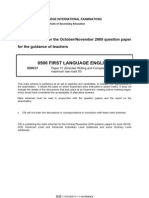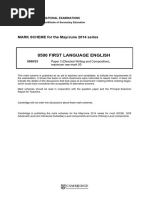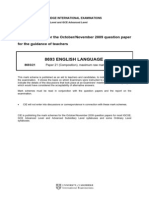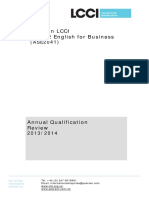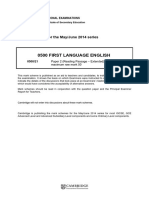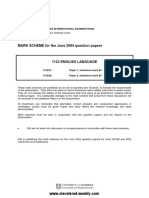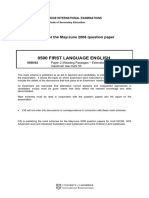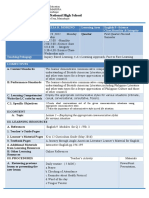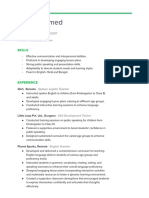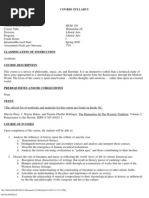0500 w05 Ms 3
0500 w05 Ms 3
Uploaded by
Jay NandwaniCopyright:
Available Formats
0500 w05 Ms 3
0500 w05 Ms 3
Uploaded by
Jay NandwaniOriginal Title
Copyright
Available Formats
Share this document
Did you find this document useful?
Is this content inappropriate?
Copyright:
Available Formats
0500 w05 Ms 3
0500 w05 Ms 3
Uploaded by
Jay NandwaniCopyright:
Available Formats
UNIVERSITY OF CAMBRIDGE INTERNATIONAL EXAMINATIONS
International General Certificate of Secondary Education
MARK SCHEME for the November 2005 question paper
0500 FIRST LANGUAGE ENGLISH
0500/03 Paper 3 (Directed Writing and Composition) Maximum mark 50
This mark scheme is published as an aid to teachers and students, to indicate the requirements of the examination. It shows the basis on which Examiners were initially instructed to award marks. It does not indicate the details of the discussions that took place at an Examiners meeting before marking began. Any substantial changes to the mark scheme that arose from these discussions will be recorded in the published Report on the Examination. All Examiners are instructed that alternative correct answers and unexpected approaches in candidates scripts must be given marks that fairly reflect the relevant knowledge and skills demonstrated. Mark schemes must be read in conjunction with the question papers and the Report on the Examination. The minimum marks in these components needed for various grades were previously published with these mark schemes, but are now instead included in the Report on the Examination for this session. CIE will not enter into discussion or correspondence in connection with these mark schemes.
CIE is publishing the mark schemes for the November 2005 question papers for most IGCSE and GCE Advanced Level and Advanced Subsidiary Level syllabuses and some Ordinary Level syllabuses.
Page 1
Mark Scheme IGCSE NOVEMBER 2005
Syllabus 0500
Paper 3
MARK SCHEME Examiners should refer to the Instructions to Examiners handbook for general administrative guidance. NB : All Examiners are instructed that alternative correct answers and unexpected approaches in candidates scripts must be given marks that fairly reflect the relevant knowledge and skills demonstrated. Section 1: Directed Writing 1 This question tests writing objectives W1-W5: articulate experience and express what is thought, felt and imagined order and present facts, ideas and opinions understand and use a range of appropriate vocabulary use language and register appropriate to audience and context make accurate and effective use of paragraphs, grammatical structures, sentences, punctuation and spelling AND aspects of reading objectives R1-R3: understand and collate explicit meanings understand, explain and collate implicit meanings and attitudes select, analyse and evaluate what is relevant to specific purposes General notes on likely content The aim of the conversation is to explain what the youngster would like and why. It should then go on to counter the criticisms intimated by Mr Pavlis letter. Details should be selected from the notes. What the youngster wants will be straightforward. In order to explain why a youth centre is wanted, they will have to discuss the current situation (as per the notes) and should also explain the positive benefits to be gained. These might be for parents or for the young people. Some of these are obvious, e.g. the teenagers will get what they want the younger children can play freely there will be less noise/disturbance on the streets Others are implicit, e.g. fitness of teens will improve IT skills may improve positive role models supplied social problems may be allayed. Candidates will, in addition, recognise and discuss Mr Pavlis concerns and will cover these in the dialogue, e.g. cost/diversion of funds from other community schemes wastefulness due to likelihood of vandalism power of bad influences to monopolise youth centre facilities negative effect on rest of community and facilities The question is marked out of 15 for Writing and 10 for Reading.
University of Cambridge International Examinations 2005
Page 2
Mark Scheme IGCSE NOVEMBER 2005
Syllabus 0500
Paper 3
Use the following table to give a mark out of 15 for WRITING Band 1 13-15 Excellent sense of audience; persuasive/authoritative style; very fit for purpose; structured overall; firmly made arguments; accurate; uses language assuredly. Demonstrates a secure sense of audience; quite stylish and fluent; sense of overall structure; arguments occasionally well developed; writing is mainly accurate, and overall language is very good. Consistently recognisable sense of audience; mostly written in accurate, if fairly straightforward sentences; some arguments based on material are apparent; mostly quite well structured; errors minor; language straightforward but effective. Written in an appropriate if sometimes inconsistent style; sentences mainly accurate; factual rather than argumentative; basic structure: has beginning, middle and end; fairly frequent (minor) errors; language simple with occasional attempts at persuasive effect. Functional expression; facts selected and occasionally listed; has a beginning, but main part of conversation is not always well sequenced; some serious errors in grammar and use of vocabulary. Language and style not clear; some blurring and lack of order; despite some serious errors, can mainly be followed. Serious inaccuracies and problems with language and grammar are too intrusive to gain a mark in Band 6.
Band 2
10-12
Band 3
8-9
Band 4
5-7
Band 5
3-4
Band 6
1-2 0
University of Cambridge International Examinations 2005
Page 3
Mark Scheme IGCSE NOVEMBER 2005
Syllabus 0500
Paper 3
Use the following table to give a mark out of 10 for READING Band 1 9-10 Offers a thorough, convincing, perceptive evaluation of the material and creates a persuasive case for support to justify and support. Reads effectively between the lines recognizing Mr Pavils concerns. Effective focus on detail and the language of the material. Good account of and clear judgement of the benefits of the centre. Sound reading between the lines. Good use overall of material. A number of points developed to make a satisfactory account and logical case for support. Fair overall grasp of material, with some evaluation. Completes task by selecting a few relevant points rather literally. Opportunities to consider the information not fully taken. Parts of the answer are relevant, though material may be repeated injudiciously. Answer does not relate to question and/or too much unselective copying directly from the material to gain a mark in Band 5.
Band 2 Band 3
7-8 5-6
Band 4 Band 5
3-4 1-2 0
University of Cambridge International Examinations 2005
Page 4
Mark Scheme IGCSE NOVEMBER 2005 Section 2: Composition
Syllabus 0500
Paper 3
2(a), 2(b), 3(a), 3(b), 4(a) and 4(b) Give two marks: the first mark is out of 13 for content and structure: see Table A the second mark is out of 12 for style and accuracy: see Table B
[Remember that these marks will not necessarily match and one mark may well be (much) higher than the other.] The maximum overall mark for the composition is 25. Write the total clearly at the end as follows (e.g.) C7 + S10 = 17 (C standing for Content, S standing for Style). [It is important that marking is not bunched: do not be reticent about awarding marks in the top and bottom bands.]
University of Cambridge International Examinations 2005
Page 5
Mark Scheme IGCSE NOVEMBER 2005
Syllabus 0500
Paper 3
Band 1 1113
Band 2 9-10
Band 3 7-8
COMPOSITION TASKS: TABLE A - CONTENT AND STRUCTURE ARGUMENTATIVE/DIS DESCRIPTIVE TASK NARRATIVE TASK CURSIVE TASK There is a consistent There are many well defined, The narrative is complex and quality of well developed, well developed ideas and sophisticated and may logical stages in an images, describing complex contain devices such as suboverall, at times complex atmospheres with a range of texts, flashbacks and time argument. details. lapses. Cogent details are provided where necessary or Each stage is linked to Overall structure is provided appropriate. and follows the through devices such as the preceding one and movements of the writer, the The different sections of the sentences within creation of a short time span, story are carefully balanced paragraphs are soundly or the creation of atmosphere and the climax carefully sequenced. or tension. There is no managed. Sentence confusion with writing a story. sequences are sometimes Repetition is avoided and the arranged to produce effects sequence of sentences makes such as the building up of the picture clear to the reader. tension or providing a sudden turn of events. Each stage of the There is a good selection of The writing develops some argument is defined and interesting ideas and images, features that are of interest developed, although the with a range of details. to a reader, although not quality of the explanation These are formed into an consistently so. Expect the may not be consistent. use of detail and some buildoverall picture of some clarity, up of character or setting. The stages follow in a largely consistent. There may generally cohesive be occasional repetition and The writing is orderly and the progression. Paragraphs opportunities for development beginning and ending (where are mostly well or the provision of detail may required) are satisfactorily sequenced, although be missed. Sentences are managed. The reader is some may finish less often well sequenced and the aware of the climax even if it strongly than they begin. description is often effective. is not managed fully effectively. The sequencing of sentences provides clarity and engages the reader in events or atmosphere. There is a series of There is a selection of A straightforward story (or relevant points and a effective ideas and images part of story) with clear attempt is made to that are relevant to the topic satisfactory identification of develop some of them. and which satisfactorily features such as character These points are address the task. An attempt and setting. relevant, straightforward is made to create atmosphere While opportunities for and logical/coherent. and to provide some details. appropriate development of Repetition is avoided, but The description provides a ideas are sometimes the order of the stages in series of points rather than a missed, the overall structure the overall argument can sense of their being combined is competent, and features of be changed without to make an overall picture, but a developed narrative are adverse effect. The some of the ideas are evident. Sentences are sequence of the developed successfully, albeit usually sequenced to narrate sentences within straightforwardly. Some events. paragraphs is sentences are well sequenced. satisfactory, although opportunities to link ideas may not be taken.
University of Cambridge International Examinations 2005
Page 6
Mark Scheme IGCSE NOVEMBER 2005 Some relevant and effective ideas are provided and occasionally developed a little, perhaps as a narrative. There is some feeling of atmosphere, but most of the writing is of event or description of objects or people. There is some overall structure, but the writing may lack direction and intent. There may be interruptions in the sequence of sentences and/or some lack of clarity.
Syllabus 0500
Paper 3
Band 4 5-6
Mainly relevant points are made and they are developed partially with some brief effectiveness. The overall argument shows signs of structure but may be sounder at the beginning than at the end. There may be some repetition. It is normally possible to follow sequences of ideas, but there may be intrusive ideas or misleading sentences. A few relevant points are made and although they are expanded into paragraphs, development is very simple and not always logical. Overall structure lacks a sense of sequencing. Paragraphs used only for obvious divisions. It is sometimes possible to follow sequencing of sentences within paragraphs. A few points are discernible but any attempt to develop them is very limited. Overall argument only progresses here and there and the sequence of sentences is poor.
Band 5 3-4
Content is relevant but lacking in scope or variety. Opportunities to provide development and detail are frequently missed. The overall structure, though readily discernible, lacks form and dimension. The reliance on identifying events, objects and/or people sometimes leads to a sequence of sentences without progression.
Band 6 1-2
Some relevant facts are identified, but the overall picture is unclear and lacks development. There are examples of sequenced sentences, but there is also repetition and muddled ordering.
Rarely relevant, little material, and presented in a disorderly structure. Not sufficient to be placed in band 6.
Rarely relevant, little material, and presented in a disorderly structure. Not sufficient to be placed in Band 6.
A relevant response to the topic, but largely a series of events with occasional details of character and setting. The overall structure is sound although there are examples where a particular section is too long or too short. A climax is identified but is not effectively described or led up to. Sentence sequences narrate events and occasionally contain intrusive facts or misleading ideas. A simple narrative with a beginning, middle and end (where appropriate). It may consist of simple, everyday happenings or unlikely, unengaging events. Unequal or inappropriate importance is given to the sections of the story. Dialogue that has no function may be used or over-used. There is no real climax. Sentence sequences are used only to link simple series of events. Stories are very simple and narrate events indiscriminately. Endings are simple and lack effect. The shape of the narrative is unclear; some of the content has no relevance to the plot. Sequences of sentences are sometimes poor, leading to a lack of clarity. Rarely relevant, little material, and presented in a disorderly structure. Not sufficient to be placed in Band 6.
University of Cambridge International Examinations 2005
Page 7
Mark Scheme IGCSE NOVEMBER 2005
Syllabus 0500
Paper 3
COMPOSITION TASKS: TABLE B: STYLE AND ACCURACY Band 1 11-12 Band 2 9-10 fluent; variety of well made sentences, including sophisticated complex sentences where appropriate, used to achieve particular effects. wide, consistently effective range of vocabulary with appropriately used ambitious words. some use of grammatical devices; assured use of punctuation; spelling accurate. mostly fluent; sentences correctly constructed, including a variety of complex sentences. vocabulary often effective, sometimes complex, mostly varied. grammatically correct; punctuation mostly correct between and within sentences; very occasional spelling mistakes. occasional fluency; sentences of some variety and complexity, correctly constructed. appropriate and accurate vocabulary with occasional examples of choice made to communicate precise meaning or to give interest. simple grammatical terms correct; sentence separation mostly correct. and other forms of punctuation perhaps inconsistently used sometimes; some spelling mistakes but no error of any sort impedes communication. sentences tend to be simple and patterns repetitive. Where more complicated structures are attempted there is lack of clarity and inaccuracy. vocabulary communicates general meaning accurately. some errors of punctuation including sentence separation; several spelling and grammatical errors, rarely serious. there may be some straightforward grammatically complex sentences, but others are simple and repetitively joined by and, but and so, with other conjunctions used ineffectively if at all. vocabulary communicates simple details/facts accurately. many errors of punctuation, grammar and spelling, but the overall meaning is never in doubt. sentences are simple and sometimes faulty and/or rambling sentences obscure meaning. vocabulary is limited and may be inaccurate. errors of punctuation, grammar and spelling may be serious enough to impede meaning. meaning of the writing is often lost because of poor control of language; errors of punctuation, grammar and spelling too intrusive to award a mark in Band 6.
Band 3
7-8
Band 4
5-6
Band 5
3-4
Band 6
1-2
University of Cambridge International Examinations 2005
You might also like
- IELTS Academic Writing: Important Tips & High Scoring Sample AnswersFrom EverandIELTS Academic Writing: Important Tips & High Scoring Sample AnswersRating: 4 out of 5 stars4/5 (25)
- Specimen Paper 3 Mark Scheme 2015Document8 pagesSpecimen Paper 3 Mark Scheme 2015Mrs_PPNo ratings yet
- Stages of Teacher Development (TROTTER, 1986)Document32 pagesStages of Teacher Development (TROTTER, 1986)DORINA WONG MING100% (3)
- Writing Mark SchemeDocument8 pagesWriting Mark SchemeMrRyanKGVNo ratings yet
- 0522 s12 Ms 3Document9 pages0522 s12 Ms 3harshilNo ratings yet
- 8001 w05 Ms 1Document2 pages8001 w05 Ms 1mrustudy12345678No ratings yet
- 0500 First Language English: MARK SCHEME For The May/June 2014 SeriesDocument9 pages0500 First Language English: MARK SCHEME For The May/June 2014 SeriesShen Yee TangNo ratings yet
- Argumentative Letter AnswerDocument10 pagesArgumentative Letter AnswerReema Sanaj100% (1)
- 0500 First Language English: MARK SCHEME For The May/June 2011 Question Paper For The Guidance of TeachersDocument8 pages0500 First Language English: MARK SCHEME For The May/June 2011 Question Paper For The Guidance of TeachersRushabh VoraNo ratings yet
- Candidate Responses BookletDocument64 pagesCandidate Responses BookletSandyDavidNo ratings yet
- MARK SCHEME For The November 2005 Question Paper: University of Cambridge International ExaminationsDocument8 pagesMARK SCHEME For The November 2005 Question Paper: University of Cambridge International ExaminationsVidhi ChhedaNo ratings yet
- June 2011 Writing Paper A Marking SchemeDocument8 pagesJune 2011 Writing Paper A Marking SchemeMobarobberNo ratings yet
- 1123 s14 Ms 11 PDFDocument9 pages1123 s14 Ms 11 PDFReem Amin Ul HaqNo ratings yet
- June 2008 MSDocument7 pagesJune 2008 MSropafadzoliandramabvudzaNo ratings yet
- June 2011 (v3) MSDocument8 pagesJune 2011 (v3) MSlaraibyunusabdulafeezNo ratings yet
- 0500 First Language English: MARK SCHEME For The October/November 2014 SeriesDocument11 pages0500 First Language English: MARK SCHEME For The October/November 2014 SeriesPrabhat DwivediNo ratings yet
- E360K English Grammar - Spring 2001Document4 pagesE360K English Grammar - Spring 2001JoeNo ratings yet
- 3204 BENGALI: MARK SCHEME For The May/June 2008 Question PaperDocument5 pages3204 BENGALI: MARK SCHEME For The May/June 2008 Question Papermstudy123456No ratings yet
- Extreme 0500-32 FIRST LANGUAGE ENGLISH 0500 - m15 - 3 - 2 - MsDocument8 pagesExtreme 0500-32 FIRST LANGUAGE ENGLISH 0500 - m15 - 3 - 2 - MsChoon Hong1No ratings yet
- 0500 First Language English: MARK SCHEME For The May/June 2015 SeriesDocument8 pages0500 First Language English: MARK SCHEME For The May/June 2015 SeriesPrabhat DwivediNo ratings yet
- 0500 w12 Ms 23Document11 pages0500 w12 Ms 23seyka4No ratings yet
- 0549 s07 Ms 1Document7 pages0549 s07 Ms 1aniket k100% (1)
- 8693 English Language: MARK SCHEME For The October/November 2009 Question Paper For The Guidance of TeachersDocument4 pages8693 English Language: MARK SCHEME For The October/November 2009 Question Paper For The Guidance of Teachersmstudy123456No ratings yet
- IGCSE 2nd Lang Engl Mark Scheme 2011 SummaryDocument3 pagesIGCSE 2nd Lang Engl Mark Scheme 2011 SummaryNathan CNo ratings yet
- Cambridge Assessment International Education: First Language Arabic 0508/02 October/November 2019Document6 pagesCambridge Assessment International Education: First Language Arabic 0508/02 October/November 2019walaa ahmadNo ratings yet
- June 2014 Mark Scheme 31Document9 pagesJune 2014 Mark Scheme 31rajeshbarasaraNo ratings yet
- English For Business Level 2Document23 pagesEnglish For Business Level 2HorváthDávidNo ratings yet
- 8001 w06 Ms 1Document10 pages8001 w06 Ms 1mrustudy12345678No ratings yet
- 0500 s16 Ms 22 PDFDocument10 pages0500 s16 Ms 22 PDFRana SidNo ratings yet
- Examiners' Commentaries 2010: 04a Statistics 1Document3 pagesExaminers' Commentaries 2010: 04a Statistics 1Adeel TariqNo ratings yet
- English B Paper 2 HL MarkschemeDocument14 pagesEnglish B Paper 2 HL MarkschemeMarcelo FonsecaNo ratings yet
- Paper 2 Mark SchemeDocument10 pagesPaper 2 Mark SchemeBoris BabaianNo ratings yet
- 1123 English Language: MARK SCHEME For The October/November 2012 SeriesDocument8 pages1123 English Language: MARK SCHEME For The October/November 2012 SeriesSimona SingiorzanNo ratings yet
- 0500 s10 Ms 22Document7 pages0500 s10 Ms 22Rana SidNo ratings yet
- Responses To Readings/ Lectures/ VideosDocument15 pagesResponses To Readings/ Lectures/ VideosAmin RayzNo ratings yet
- 0500 w12 Ms 31Document9 pages0500 w12 Ms 31ktyasirNo ratings yet
- Igcse English June 2011 Paper 2 c MsDocument8 pagesIgcse English June 2011 Paper 2 c MsAnshita RajeshNo ratings yet
- 1123 s04 Ms 12Document21 pages1123 s04 Ms 12Saad ArsalanNo ratings yet
- Screenshot 2022-02-24 at 08.20.20 PDFDocument8 pagesScreenshot 2022-02-24 at 08.20.20 PDF16050007 Jessie Nathanielle De EstelitaNo ratings yet
- ESL Curriculum Guide - A Resource For TeachersDocument92 pagesESL Curriculum Guide - A Resource For TeachersJuhwan KimNo ratings yet
- 0508 First Language Arabic: MARK SCHEME For The October/November 2011 Question Paper For The Guidance of TeachersDocument5 pages0508 First Language Arabic: MARK SCHEME For The October/November 2011 Question Paper For The Guidance of Teacherswalaa ahmadNo ratings yet
- IELTS WritingDocument14 pagesIELTS Writingalexandra.stan9824100% (1)
- Clb 7 Exit Test TemplateDocument9 pagesClb 7 Exit Test TemplateSami Sami MengistuNo ratings yet
- 7.1.3 Assessment CriteriaDocument4 pages7.1.3 Assessment Criteriaapi-233965229No ratings yet
- MARK SCHEME For The June 2005 Question PapersDocument4 pagesMARK SCHEME For The June 2005 Question Papersmrustudy12345678No ratings yet
- Academic Writing Task 1 Grammatical Structures For Describing DiagramsDocument12 pagesAcademic Writing Task 1 Grammatical Structures For Describing DiagramsMostafa AzarakhshiNo ratings yet
- 0500 First Language English: MARK SCHEME For The October/November 2010 Question Paper For The Guidance of TeachersDocument9 pages0500 First Language English: MARK SCHEME For The October/November 2010 Question Paper For The Guidance of Teachersinamdarvedant17No ratings yet
- Mongolia Mark SchemeDocument7 pagesMongolia Mark SchemeFreddieNo ratings yet
- 0500 w16 Ms 31Document8 pages0500 w16 Ms 31Mohammed MaGdyNo ratings yet
- Assessment: Writing Comprehension AssessmentDocument20 pagesAssessment: Writing Comprehension AssessmentA. TENRY LAWANGEN ASPAT COLLENo ratings yet
- Cambridge IGCSE™: First Language English 0500/21 October/November 2021Document10 pagesCambridge IGCSE™: First Language English 0500/21 October/November 2021Iman HamedNo ratings yet
- Ac3093 Exc21Document21 pagesAc3093 Exc21slimshadyNo ratings yet
- English 015 Syllabus FA 14Document5 pagesEnglish 015 Syllabus FA 14fonash120No ratings yet
- Results - TDaltonDocument2 pagesResults - TDaltontraceydaltonNo ratings yet
- Letter Grade Bands: Highly Effective: Fluent: Style: Almost First LanguageDocument3 pagesLetter Grade Bands: Highly Effective: Fluent: Style: Almost First LanguageNathan CNo ratings yet
- 0500 w16 Ms 33Document8 pages0500 w16 Ms 33Mohammed MaGdyNo ratings yet
- Assessment Brief - Assessment BankDocument4 pagesAssessment Brief - Assessment Bankkhaidd21404caNo ratings yet
- Mastering IELTS Writing: Strategies and Skills for High ScoresFrom EverandMastering IELTS Writing: Strategies and Skills for High ScoresNo ratings yet
- IELTS High Score System: Learn How To Identify & Answer Every Question With A High Score!From EverandIELTS High Score System: Learn How To Identify & Answer Every Question With A High Score!Rating: 3 out of 5 stars3/5 (2)
- DLL Eng.9 - 17Document4 pagesDLL Eng.9 - 17Amelia MorenoNo ratings yet
- The Literacy Learning ProgressionsDocument32 pagesThe Literacy Learning ProgressionstestvrocNo ratings yet
- TEFL International TESOL PresentationDocument3 pagesTEFL International TESOL PresentationTesol Tefl CentreNo ratings yet
- Training and DevelopmentDocument20 pagesTraining and DevelopmentashairwaysNo ratings yet
- Athletic Handbook FinalDocument84 pagesAthletic Handbook Finalapi-205191015100% (1)
- DPS and DPD Intergovernmental AgreementDocument9 pagesDPS and DPD Intergovernmental AgreementMichael_Lee_RobertsNo ratings yet
- New CVDocument2 pagesNew CVnishatahmed949No ratings yet
- Checklist For EMI Course Development and ImplementationDocument2 pagesChecklist For EMI Course Development and ImplementationNhu NguyenNo ratings yet
- Lets SparDocument3 pagesLets Sparapi-296514525No ratings yet
- The Upgraded Project MethodDocument1 pageThe Upgraded Project Methodjdg178No ratings yet
- CAIDocument3 pagesCAIPeter Paul EnanoNo ratings yet
- The Cambridge English Scale Explained: A Guide To Converting Practice Test Scores To Cambridge English Scale ScoresDocument3 pagesThe Cambridge English Scale Explained: A Guide To Converting Practice Test Scores To Cambridge English Scale ScoresTC CarlosNo ratings yet
- 10th State Textbook Social ScienceDocument312 pages10th State Textbook Social ScienceAbhishek M SNo ratings yet
- IGCSE History Revision Site PPT ConclusionDocument13 pagesIGCSE History Revision Site PPT Conclusioncchan1120No ratings yet
- The Learner: "Every Child Is A Potential Genius."Document5 pagesThe Learner: "Every Child Is A Potential Genius."Jamillah Ar GaNo ratings yet
- Statement of Purpose: Personal IntroductionDocument2 pagesStatement of Purpose: Personal Introductioncity cyberNo ratings yet
- Statement of ResultDocument1 pageStatement of ResultAlina MariaNo ratings yet
- Guidelines For SOPSDocument2 pagesGuidelines For SOPSprashanth10gmNo ratings yet
- Parent-Teacher LettersDocument8 pagesParent-Teacher Lettersapi-242270654No ratings yet
- Writing FlowchartDocument42 pagesWriting FlowchartRahmat Hidayat RivaiNo ratings yet
- HUM 120 SyllabusDocument4 pagesHUM 120 Syllabusglyph65No ratings yet
- Organizational Behaviour:: Introduction To LeadershipDocument4 pagesOrganizational Behaviour:: Introduction To LeadershipshwetambarirupeshNo ratings yet
- CBC Elect Install & Maint NC IIIDocument105 pagesCBC Elect Install & Maint NC IIIRez Hablo100% (1)
- 6 SAT Essay Examples To Answer Every PromptDocument16 pages6 SAT Essay Examples To Answer Every PromptperwinsharmaNo ratings yet
- DLL ORAL COMM For TomDocument3 pagesDLL ORAL COMM For TomCRox's BryNo ratings yet
- Elementary Education in IndiaDocument10 pagesElementary Education in IndiaAnisten AntoNo ratings yet
- Numerology Numeric CodeDocument13 pagesNumerology Numeric Codedeep mitraNo ratings yet
- EltmDocument8 pagesEltmRaraaaNo ratings yet
- Case Study Research DesignDocument4 pagesCase Study Research Designnafi annuryNo ratings yet



